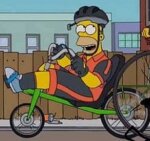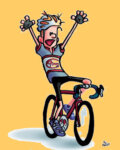Upcoming Micromobility Ordinance will also regulate e-bikes
Our Community › Forums › General Discussion › Upcoming Micromobility Ordinance will also regulate e-bikes
- This topic has 51 replies, 19 voices, and was last updated 5 years, 8 months ago by
Dewey.
-
CreatorTopic
-
October 30, 2019 at 9:20 pm #921468
 chris_sParticipant
chris_sParticipantHey all – on November 16th the County Board will vote on the “micromobility ordinance”. Most folks think of this as the “scooter ordinance” but it’s going to have major impacts on bikes and e-bikes as well.
For instance: legalizes e-bikes on trails. Sets a speed limit for e-bikes on trails. Gives the County Manager the ability to ban bikes from certain sidewalks without defining any clear public process for making that decision. Sets a speed limit for e-bikes on sidewalks (probably at 6mph). Bans e-bikes on sidewalks on blocks that have a protected bike lane.
Read more here and let the County Board know what you think.
-
CreatorTopic
-
AuthorReplies
-
November 4, 2019 at 3:11 pm #1101033
n18
ParticipantA better approach than just making a general speed limit; is to limit the speed only the closer you are to a pedestrian/pet/wheelchair. If you are within 2 feet, the limit might be 8-10 MPH, one foot 5 MPH. No peds maybe 15 MPH, or not restricted. I think 6 MPH was chosen because it’s twice walking speed. One issue I have with general speed limits like this is when the sidewalks/trails are empty outside busy hours; like around 9 to 10 PM after stores are closed, when some cyclists are leaving work. It’s ridiculous to go 6 MPH when the sidewalks are empty.
I use the sidewalks on Maple AVE in Vienna often; I stop for every pedestrian, otherwise I keep my speed around 10 to 15 MPH. At night, when the sidewalks are empty, I go as fast as possible/reasonable, 18 MPH tops. I don’t want other cyclists/scooters to act like jerks so the town imposes speed limits, etc. You abuse it, you lose it!
November 4, 2019 at 4:01 pm #1101034dasgeh
Participant@scoot 194021 wrote:
I do however think that the setting should be a factor, with different limits for streets vs. trails vs. sidewalks. Bike lanes should be considered as part of the street, with the same speed limit as required for automobiles. Certainly for un-“protected” lanes, such as those that are immediately adjacent to vehicles, it would be absurd to set a different speed limit. However, I could be convinced that PBLs belong in the trail class with a universal 15-20MPH limit; many PBLs are unsafe at those speeds anyway due to turning conflicts, visibility obscurations, and proximity to pedestrians. I also think it’s reasonable to set a lower speed limit for sidewalks than for PBLs/trails.
The problem with this approach is that there are too many gray areas in Arlington today. E.g.
– is the Custis in Rosslyn a sidewalk or a trail? What about the westside Rte 50 beside Fairfax Drive near the Red Lion Hotel? Or the northside Rte 50 trail on the bridge over the W&OD/FMR trails? How would anyone know?
– are buffered bike lanes PBLs (e.g. Quincy near the Central Library) or “street” bike lanes? What about where there’s a PBL that have a mixing zone (northbound Quincy at Wilson; southbound Veitch at Wilson)? Or when it’s supposed to be protected but the protection gets moved (southbound Quincy near the car dealership at Glebe)?ACPD still harasses cyclists with rules that are unclear (recently a woman was stopped for not hugging the curb on Marshall Drive, where there’s a grate on the curb and a blind hill) and when asked, the police chief defended the officer), so these aren’t meaningless issues.
November 4, 2019 at 6:36 pm #1101037EasyRider
Participant@mstone 194063 wrote:
We’ve already been repeatedly assured that ebikes can’t speed because classes. So a 20MPH speed limit does absolutely nothing. (Logically it can’t be enforced until someone’s doing 30, which will come up so seldom that there’s zero chance that the police will commit resources to it.) If there’s a serious desire to implement a rule to improve safety, then it needs to mandate taking trail conditions into account (a speed of 15MPH is way too fast for a crowded trail, and a speed of 25MPH doesn’t affect anyone if the trail is empty–I’m much more concerned by things like passing dangerously than by absolute speed). But mandating safe behavior is hard, and slapping a useless speed limit sign on the trail is easy, so we get the useless one.
I see you point, but I guess I’d say there are rules, and then there are norms. To me, the value in a speed limit sign is the norm that it communicates — that it isn’t OK to go as fast as you please without concern for more vulnerable trail users. There’s an implied threat of enforcement that is yes, largely toothless. I’m open to alternative signage that communicates the need for courteous behavior in a simple, brief way. We could just put up more “Hey, be a PAL” signs and hope that works.
November 4, 2019 at 6:38 pm #1101038scoot
Participant@dasgeh 194065 wrote:
@scoot 194021 wrote:
I do however think that the setting should be a factor, with different limits for streets vs. trails vs. sidewalks. Bike lanes should be considered as part of the street, with the same speed limit as required for automobiles. Certainly for un-“protected” lanes, such as those that are immediately adjacent to vehicles, it would be absurd to set a different speed limit. However, I could be convinced that PBLs belong in the trail class with a universal 15-20MPH limit; many PBLs are unsafe at those speeds anyway due to turning conflicts, visibility obscurations, and proximity to pedestrians. I also think it’s reasonable to set a lower speed limit for sidewalks than for PBLs/trails.
The problem with this approach is that there are too many gray areas in Arlington today. E.g.
– is the Custis in Rosslyn a sidewalk or a trail? What about the westside Rte 50 beside Fairfax Drive near the Red Lion Hotel? Or the northside Rte 50 trail on the bridge over the W&OD/FMR trails? How would anyone know?
– are buffered bike lanes PBLs (e.g. Quincy near the Central Library) or “street” bike lanes? What about where there’s a PBL that have a mixing zone (northbound Quincy at Wilson; southbound Veitch at Wilson)? Or when it’s supposed to be protected but the protection gets moved (southbound Quincy near the car dealership at Glebe)?ACPD still harasses cyclists with rules that are unclear (recently a woman was stopped for not hugging the curb on Marshall Drive, where there’s a grate on the curb and a blind hill) and when asked, the police chief defended the officer), so these aren’t meaningless issues.
Good points. My use of “should” in my first sentence was too strong… I should change it to “could”
My main arguments on this topic are:
1) I strongly oppose instituting different speed limits for different vehicle classes using the same facility. My understanding is that the draft ordinance would set a lower speed limit for scooters and e-bikes riding on streets than that which is posted for automobiles. (The lower speed limits would not apply to conventional human-powered bicycles.) There certainly do exist safety considerations relevant for riders of small-wheeled scooters maneuvering at street speeds, but these types of vehicles should never be subject to a more restrictive legal speed limit than automobiles when using the same roadway. Scooters and e-bikes have nowhere near the same capability of inflicting damage on other street users as do automobiles.
but
2) Assuming all mobility devices are treated equally, I could support different speed limits for different types of facilities. If it is possible to implement these in a transparent and comprehensible fashion. Obviously that’s a really big if (as you have duly noted with various examples), and I completely ignored those details. But it is reckless to ride any device at 25MPH on a crowded sidewalk, and I have no problem with an ordinance that would prohibit this. The (unenforceable?) 15MPH limit on area trails is itself a recognition of the fact that bicyclists need to slow down when sharing facilities with pedestrians.
As for PBLs, I could go either way, as my original post indicated. Most PBL designs in use in this region are unsafe for riding above 15MPH, so PBL users should somehow be encouraged to ride more slowly there than they might in other places. But I’m not sold on speed limit regulation specific to certain bike lanes as a useful approach for that; the downsides probably outweigh any upside.
November 4, 2019 at 6:53 pm #1101039scoot
Participant@dasgeh 194065 wrote:
ACPD still harasses cyclists with rules that are unclear (recently a woman was stopped for not hugging the curb on Marshall Drive, where there’s a grate on the curb and a blind hill) and when asked, the police chief defended the officer), so these aren’t meaningless issues.
Are you referring to Marshall Drive eastbound from Fort Myer downhill towards 110 (where there is a grate at the bottom of the dip before a short rise)? That lane is far too narrow (11 feet maybe?) to share with a motor vehicle, and any cyclist should claim the whole lane. I hope we have weighed in with ACPD?
November 4, 2019 at 7:55 pm #1101043dasgeh
Participant@scoot 194071 wrote:
Are you referring to Marshall Drive eastbound from Fort Myer downhill towards 110 (where there is a grate at the bottom of the dip before a short rise)? That lane is far too narrow (11 feet maybe?) to share with a motor vehicle, and any cyclist should claim the whole lane. I hope we have weighed in with ACPD?
Yep, there. Chief Farr claims the lane is 12 feet wide, and reasons that a bike is 3′, an average car 6′, so there’s room for a car to pass with a 3′ buffer if a bike is as far right as possible. He claims that it is better for the bike to be right so that a car will pass on the right side of the double yellow, because there is a blind hill. I disagree.
It has yet to be brought up… I’ve been mulling possibilities.
November 4, 2019 at 8:05 pm #1101044 bentbike33Participant
bentbike33Participant@dasgeh 194076 wrote:
Yep, there. Chief Farr claims the lane is 12 feet wide, and reasons that a bike is 3′, an average car 6′, so there’s room for a car to pass with a 3′ buffer if a bike is as far right as possible, and the car’s tires are on the right hand line of the double yellow.
FTF the Chief
November 4, 2019 at 8:19 pm #1101045Brendan von Buckingham
ParticipantChief Farr should ride a bike up that hill and let me pass him in my SUV. Bet I could change his mind.
November 4, 2019 at 8:37 pm #1101046scoot
Participant@dasgeh 194076 wrote:
Yep, there. Chief Farr claims the lane is 12 feet wide, and reasons that a bike is 3′, an average car 6′, so there’s room for a car to pass with a 3′ buffer if a bike is as far right as possible. He claims that it is better for the bike to be right so that a car will pass on the right side of the double yellow, because there is a blind hill. I disagree.
It has yet to be brought up… I’ve been mulling possibilities.
An average car may be six feet, but trucks, SUVs, and buses are wider. Riding to the right encourages dangerous passes by larger vehicles. And it also encourages dangerous passes even by smaller vehicles that will certainly not be driven right on the yellow line due to fears of a head-on collision. Not to mention the obvious dangers of the curb and grate.
The rule of thumb that I recall learning for deciding whether a lane should be taken or whether it can be safely shared side-by-side is 14 feet. ShareVARoads.org’s guidelines, endorsed by VDOT, stipulate that a cyclist should take the lane whenever the lane is “of ordinary width (10-12 feet)” (see “Take the Lane”, page 10). I’m not aware of any relevant court ruling though.
November 4, 2019 at 9:32 pm #1101048dasgeh
Participant@scoot 194079 wrote:
The rule of thumb that I recall learning for deciding whether a lane should be taken or whether it can be safely shared side-by-side is 14 feet. ShareVARoads.org’s guidelines, endorsed by VDOT, stipulate that a cyclist should take the lane whenever the lane is “of ordinary width (10-12 feet)” (see “Take the Lane”, page 10). I’m not aware of any relevant court ruling though.
Thanks for finding this. I note the Oxford comma in that sentence is helpful to our cause.
November 5, 2019 at 1:27 pm #1101054mstone
Participant@EasyRider 194069 wrote:
I see you point, but I guess I’d say there are rules, and then there are norms. To me, the value in a speed limit sign is the norm that it communicates — that it isn’t OK to go as fast as you please without concern for more vulnerable trail users. There’s an implied threat of enforcement that is yes, largely toothless. I’m open to alternative signage that communicates the need for courteous behavior in a simple, brief way. We could just put up more “Hey, be a PAL” signs and hope that works.
The problem is, that isn’t what the sign communicates. It says that you’re perfectly ok going 15MPH (+ the 10MPH courtesy window) which is flat out dangerous on a crowded trail. If the intent is to encourage safe trail use, then the implementation should align with that goal–not slap on a speed limit so that bikes have to “follow the same rules as cars” even though the concerns and vehicles are more different than the same. (A speed limit sign for a car is greatly restrictive–a 20MPH bike speed limit would be like a 120MPH car speed limit, and how many of those do you see in the area?) I would love to see ideas for legislating safe behavior (rather than arbitrary and capricous restrictions that don’t really enhance safety) but it seems that it’s really hard to do so (and the concern dasgeh raised about selective/harassing enforcement is huge when it comes to things that boil down to using good judgment).
November 5, 2019 at 2:58 pm #1101057 Steve OParticipant
Steve OParticipant@dasgeh 194081 wrote:
Thanks for finding this. I note the Oxford comma in that sentence is helpful to our cause.
This is on page 18 of the same document:
How far to the right?
Bicyclists should not hug the curb or road edge since this position makes bicyclists less visible to motorists, promotes unsafe motorist passing, and exposes bicyclists to various hazards. While bicyclist are required to stay “as far right as safely practicable,” it is clearly not practicable to share travel lanes less than 14 feed wide with autos. Bicyclists should position themselves to maximize visibility and vantage and to discourage motorists from turning right into them. Bicyclists may use the shoulders or take the lane.November 5, 2019 at 3:14 pm #1101058 Steve OParticipant
Steve OParticipantFor those who are unfamiliar, here is the road in question. There is no frickin’ way any experienced person riding a bicycle would hug the curb to allow cars to pass on this blind rise. As both an experienced rider and a League Certified Instructor, I would advise anybody to take the middle of this lane for their own safety. Even now that I have been informed one could be issued a ticket, I would still advise that. Anything less is putting themselves in potential danger.
[ATTACH=CONFIG]20477[/ATTACH]November 5, 2019 at 3:14 pm #1101059scoot
Participant@Steve O 194090 wrote:
This is on page 18 of the same document:
How far to the right?
Bicyclists should not hug the curb or road edge since this position makes bicyclists less visible to motorists, promotes unsafe motorist passing, and exposes bicyclists to various hazards. While bicyclist are required to stay “as far right as safely practicable,” it is clearly not practicable to share travel lanes less than 14 feed wide with autos. Bicyclists should position themselves to maximize visibility and vantage and to discourage motorists from turning right into them. Bicyclists may use the shoulders or take the lane.Nice find.
November 5, 2019 at 3:34 pm #1101022n18
ParticipantRather than passing laws to regulate behavior that is not easily/seldom enforced, I suggest instead mandating that scooter/Ebike operators/bike shops require new registrants/potential buyers to visit a particular county web page. That page would post guidelines(like in my post here is this thread) in how to behave around pedestrians, and that failure to follow these guidelines could results in new laws restricting or prohibiting certain devices or activities.
Many cyclists/scooters copy what others are doing in what I call “deducing laws by the way they are enforced”. At least with a guideline document you could train new comers to a better safer behavior. Another reason things are bad the way they are is that not everyone who cycles/scoots knows this forum, so they are not aware they are doing anything wrong. The link to this forum is not easy to spot at http://www.bikearlington.com/ Can you find it?(It’s the green icon on top of the page)
Edited to add: At least with this approach we reduce the statistics of abuse/misuse, we gain something without spending a penny, and without burdening those who ride safely around pedestrians.
-
AuthorReplies
- You must be logged in to reply to this topic.